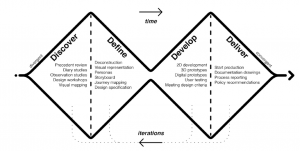RT33 – Selby Coxon – Design Research Innovations in Public Transport
Researching Transit – Episode 33
Published: September 2021
Keywords: Public transport, industrial design, manufacturing, mobility
This is the eleventh episode in Researching Transit’s Handbook of Public Transport Research Series. Links to the book can be found at the end of the notes.
In this episode, Professor Graham Currie talks to Associate Professor Selby Coxon of Monash University’s Department of Design. Associate Professor Coxon is the Director of the Mobility Design Lab and also the Associate Dean Graduate Research for the Faculty of Art, Design and Architecture. He has been involved in industrial design in both academia and the commercial sector for around 30 years.
Professor Currie and Associate Professor Selby Coxon discuss the work of the Mobility Design Lab, which is focused around two themes: decarbonising transport; and developing mobility solutions for dense urban environments. The Mobility Design Lab builds on Monash University’s long history of educating students who went on to work in the automotive industry, but adopts a broader focus to also consider public transport and other forms of mobility, not just personal cars. Examples of research from the Mobility Design Lab have previously been discussed with Dr Robbie Napper on episode 21 of this podcast.
This episode focuses on the sixth chapter of the Handbook of Public Transport Research: The power of design to enrich the public transport experience. The chapter was authored by Associate Professor Coxon, Dr Robbie Napper, Dr Ilya Fridman and Dr Vincent Moug. It discusses how design processes can be used to improve transport systems, and takes the reader through the British Design Council’s “Double Diamond model”. This model involves iterative steps based on 4Ds: Discover, Define, Develop and Deliver, as shown in Figure 1.
Figure 1: Double Diamond design process, based on British Design Council. Source: Coxon et al. (2021, p. 94)
In this episode Associate Professor Coxon discusses how the design process involves both divergent and convergent thinking. In the first step (Discover) designers seek to gain a broad understanding of the issues to be addressed. The second step (Define) involves synthesising collected data, developing an understand of the key issues to be addressed, and ultimately converging back to create a design specification. This is followed by a return to divergent thinking in the third step (Develop) as designers seek to draw, explore and test potential solutions. In the final step of the process (Deliver) the designer seeks to converge the potential solutions into a design output.
Overall the design process is a form of action research, where the research is done through the production of a new design, process or object. Towards the end of this episode Associate Professor Coxon discusses some of the challenges for research in industrial design, and also some of the benefits that can be gained through adopting design approaches more broadly in practice. While these have already been widely applied to increase the attactiveness of private automobiles, there appears to be much opportunity for such approaches to be used more generally to improve transit and mobility systems.
Find out more about this research in Chapter 6 of the Handbook of Public Transport Research, available for purchase from the publisher’s website: https://www.e-elgar.com/shop/gbp/handbook-of-public-transport-research-9781788978651.html.
Find out more about Associate Professor Selby Coxon and his work:
Find out more about the Mobility Design Lab:
Have feedback? Find us on twitter and Instagram @transitpodcast or using #researchingtransit
Music from this episode is from https://www.purple-planet.com
References
Coxon, S, Napper, R, Fridman, I & Moug, V 2021, ‘The power of design to enrich the public transport experience’, in G Currie (ed.), Handbook of Public Transport Research, Edward Elgar Publishing Limited, Cheltenham, Gloucestershire, pp. 92-114.
- Date September 19, 2021
- Tags Podcast

